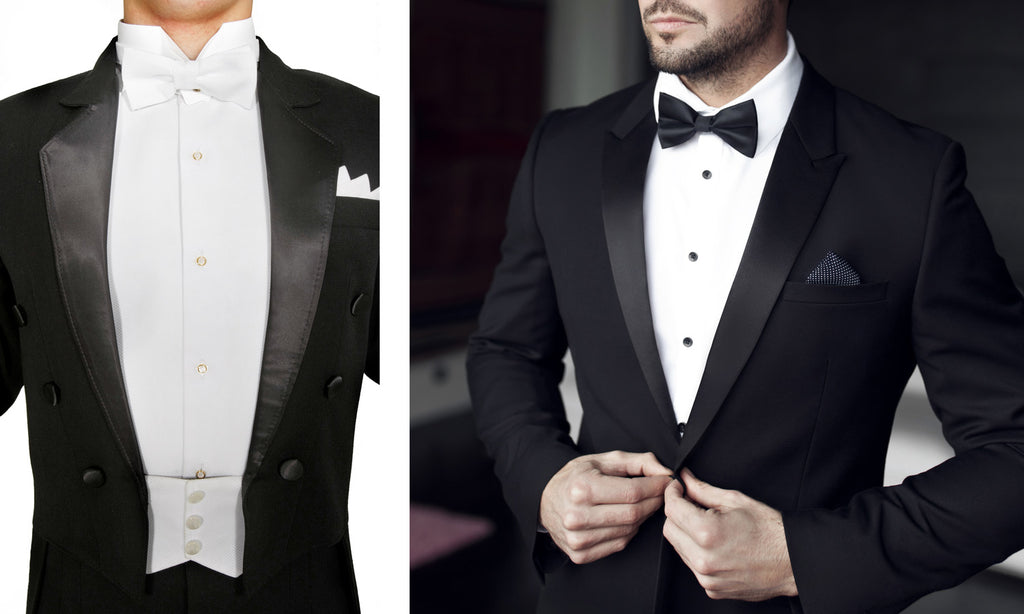White Tie Dress Code vs Black Tie

Fashion trends come and go, but Black Tie and White Tie dress codes are as evergreen as they come.
Clean, crisp, and formal, Black Tie and White Tie attire can be positively transformative - instantly inspiring you to feel confident and elegant; even festive.
… That is to say, if you know what to wear. Let's explore the differences between White Tie and Black Tie, look at which is more formal, and which type of event calls for which dress code.

What Is The Difference Between Black Tie And White Tie Dress Codes?
Black Tie (and Black Tie Optional) are dress codes we see fairly often - but White Tie events are far less common nowadays.
Nonetheless, distinguished gentlemen must know the difference between them all. Here is a quick visual guide:

White Tie Attire
White Tie calls for a tuxedo or tuxedo tailcoat with peaked lapels - and, therefore, a tuxedo shirt with cufflinks and, ideally, mother of pearl studs. A white waistcoat and black patent leather shoes are expected too.
As the code suggests, White Tie requires a white bow tie; silk or cotton pique is best (and we have some gorgeous ones!).
Other white accessories are welcome, of course, such as white gloves, a white pocket square, and a white flower at your lapel, traditionally a carnation. Top hats and tails are often worn with White Tie at the most formal of events, although it’s a choice more often made in Europe and by more senior gentlemen.
Now that we’ve covered what is White Tie, some words of caution of what White Tie is not!
- A suit will not suffice; you will be underdressed
- Do not wear a white coat
- The tuxedo shirt is mandatory; do not wear a dress shirt
- Shirting and fine accessories must be white; no creative license
- Bow tie only; never a necktie
- Choose a self tie bow tie, never pre-tied
- Formal black patent leather shoes are important; do not substitute
Black Tie Attire
Whereas the White Tie dress code is prescribed, there’s a bit more room for interpretation and personal expression with Black Tie events. As such, it’s important to read the event invitation carefully, being mindful to consider who will be attending, and the location of the event. Some invitations will even spell out what is expected by way of guest attire.
If you get the sense that the “who’s who” will attend the Black Tie event or that the locale is undeniably formal, wear a tux. If the crowd will be younger or feature notably creative folks, the host may indicate Black Tie Optional, which adds dark suits and the potential for splashes of color to the dress code. If you’re unsure of what to wear, clarify with the host or venue.

When the dress code is Black Tie, you should wear a bow tie and matching cummerbund. The most formal of Black Tie affairs might favor a black bow tie and cummerbund set, but for events less formal or centered on a theme you can wear a bow that suits your preference.
A holiday event, for example, may inspire you to sport a red and green set; a gala in support of breast cancer awareness may call for a bit of pink.
Is White Tie or Black Tie More Formal?
Fortunately, answering the White Tie vs Black Tie formality question is easy. White Tie is always more formal than Black Tie. And for those Black Tie events where a suit is acceptable, White Tie is more formal by far.
Wearing Black Tie to a White Tie affair and vice versa is a major faux pas. As aforementioned, if you are unsure of what attire is appropriate, check in with your host or the event venue.
When Should You Wear White Tie vs Black Tie?
Events that feature titled individuals or those with high social standing are usually White Tie. If a president, royalty, or diplomat will be in attendance, there is high likelihood that the dress code will be White Tie.
Note that it is not customary to wear White Tie to a wedding, but performers of classical music frequently embrace White Tie attire.

Black Tie events tend to occur at night and have a celebratory atmosphere. Award and recognition ceremonies as well as galas are often Black Tie, and some wedding invitations indicate Black Tie.
Black Tie vs White Tie Reference Guide
We’ve created a convenient Black Tie vs White Tie chart for quick reference. Should you need additional advice on what to wear (or not to wear), contact our shop - the R. Hanauer team would be delighted to help.
|
White Tie |
Black Tie |
|
Most Formal |
Formal |
|
Tuxedo, Tuxedo with Tails |
Tuxedo without Tails |
|
Tuxedo Shirt |
Tuxedo Shirt |
|
White Bow Tie |
Black or Preferred Bow Tie |
|
White Waistcoat |
Corresponding Cummerbund |
|
White Pocket Square |
Complementary Pocket Square |
|
Black Patent Leather Shoes |
Formal Shoes |
|
White Gloves, Flower & Top Hat Optional |
Preferred Additional Accessories, in moderation |
|
Presidential, Royal, Diplomatic Events |
Galas, Award Ceremonies, Some Weddings |
For inspiration on what to wear, and to share your formal looks with #RHanauer, find us on social media - we’re on Facebook and Instagram. Need more Style Fundamentals guides? We have a number of helpful articles across our blog, and we’re always here if you need one-on-one advice - reach out!

